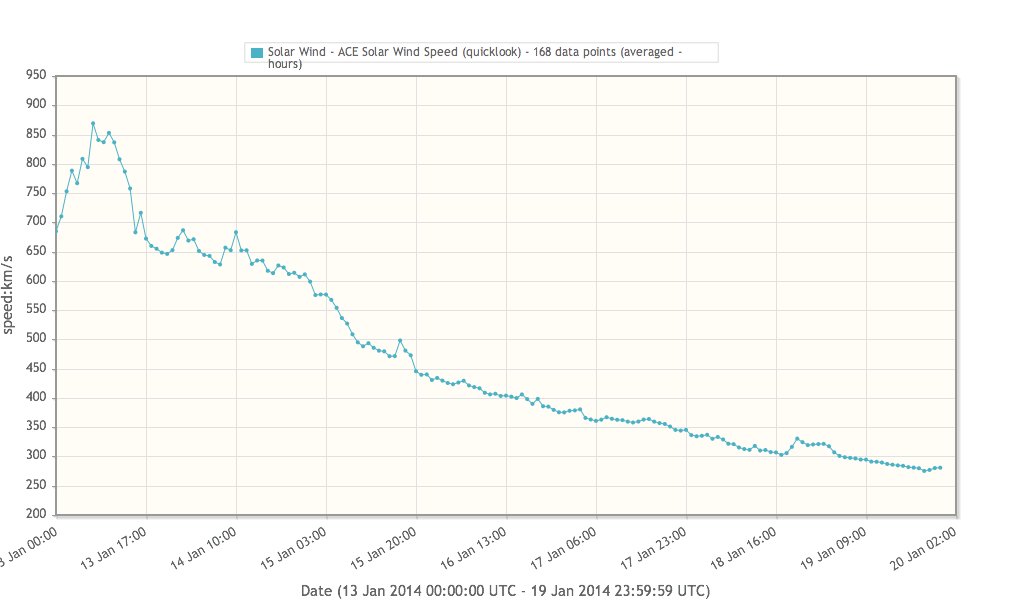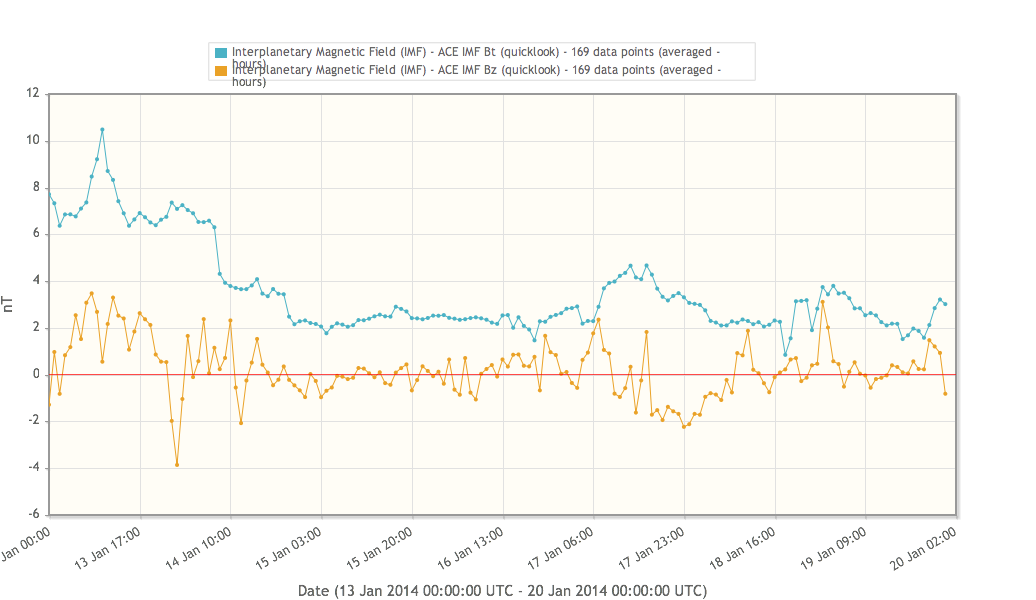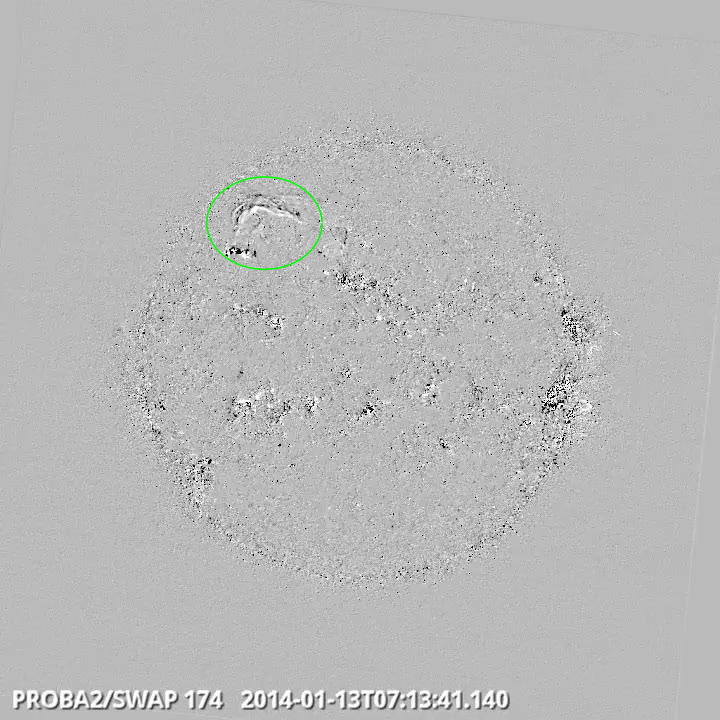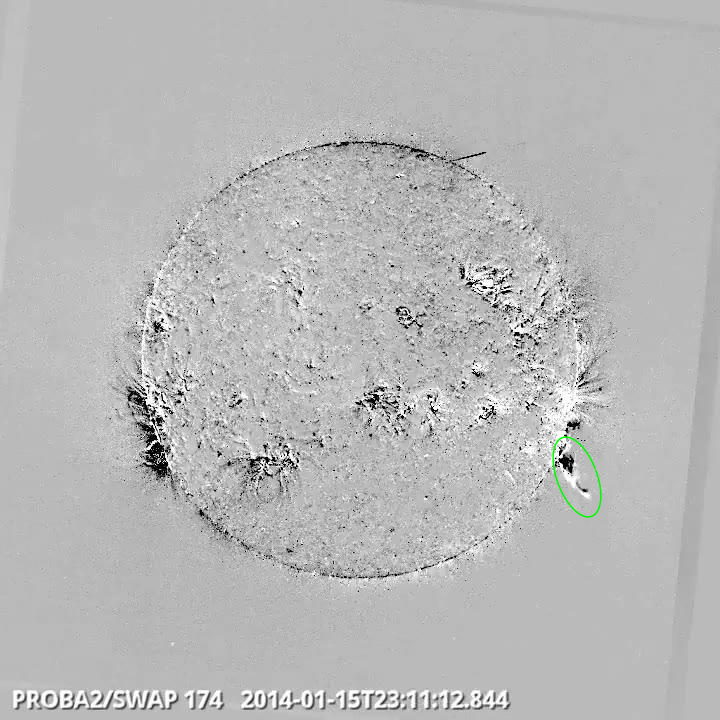
The Solar-Terrestrial Centre of Excellence (STCE) is a collaborative network of the Belgian Institute for Space Aeronomy, the Royal Observatory of Belgium and the Royal Meteorological Institute of Belgium.
 |
Published by the STCE - this issue : 24 Jan 2014. The Solar-Terrestrial Centre of Excellence (STCE) is a collaborative network of the Belgian Institute for Space Aeronomy, the Royal Observatory of Belgium and the Royal Meteorological Institute of Belgium. |
| Archive of the newsletters | Subscribe to this newsletter by mail |
Solar activity seems to have shifted into higher gear. Indeed, 2014 has hardly started, yet we have already recorded 2 proton events (see previous STCE Newsletter at http://stce.be/news/232/welcome.html ). A proton is the positively charged nucleus of the hydrogen atom. For reasons solar scientists do not fully understand, these protons are sometimes released during (usually) strong solar flares. The particles travel at very high speeds (several 10.000 km/s!) and can bridge the Sun-Earth distance in a matter of hours. For example, during the Bastille Day event (14 July 2000), the first protons arrived already within 30 minutes after the peak of the solar flare (images underneath).

During the nineties, NOAA developed a scale to categorize the intensity of these events. This S-scale (http://www.swpc.noaa.gov/NOAAscales/index.html#SolarRadiationStorms ), short for solar radiation storm, has 5 levels going from minor (S=1) to extreme (S=5). In order to be categorized as a solar proton event (SPE), one looks at the number of protons having an energy of at least 10 MeV (a unit of energy - see note 1). If the intensity of these protons is at least 10 pfu (a unit of flux intensity - see note 2) at geosynchronous altitudes, then it is categorized as an S1-event.
The interesting part is that this scale is actually logarithmic. Indeed, in order to have a moderate proton event (S2), the proton flux needs to reach 100 pfu (=10*10), not 20! And for a major event (S3), a 1000 pfu (=10*10*10) is required. Analogous steps for a severe (S=4) and extreme (S=5) proton event.

To get an idea what these numbers mean, let's take a look at what SOHO's LASCO/C3 coronagraph (http://sohowww.nascom.nasa.gov/ ) experiences when it is bombarded by all these energetic protons. For a scale of S=1 to S=4, the figure above depicts how the coronagraph's field of view is affected. The increasing number of white dots and stripes are all impacts of protons on the camera's pixels. No wonder that during a severe event, a satellite's star tracker can no longer distinguish between true stars and impacts from the protons, and can thus become disoriented. A satellite can direct itself away from the Sun, such that sunlight no longer reaches the solar panels and thus depriving itself of the precious energy.
So far this solar cycle, the Sun has produced only four S3 events and zero S4 events. The strongest was the 7 March 2012 event when flux levels reached 6530 pfu. During the previous solar cycle, six S4 events were produced, the strongest reaching 31.700 pfu on 6 November 2001 following an X-class solar flare 2 days earlier (see the image above).
No S5-event has been recorded since measurements began in 1976, but one of the strongest SPE of the space age took place early August 1972. This was right in between the Apollo-16 and -17 missions which took place resp. in April and December of the same year. The event accounted for about 70% of the total 10 MeV fluence for the complete solar cycle (SC20)! Since this large event made such a dominant contribution to the total solar cycle fluence, some research scientists decided to separate it from the other events, and to class it as an anomalously large (AL) event, in contrast to the remaining ordinary events. It is commonly accepted that if an Apollo mission had flown during the August 1972 event, the astronauts would have received severe (and potentially lethal) doses of radiation (Note 3 for reference and further reading).

Note 2 - pfu: proton flux unit. This is the number of particles registered per second, per square cm, and per steradian.
Note 3 - Further reading at SPENVIS (https://www.spenvis.oma.be/help/background/flare/flare.html ), ESA's SW web server (http://www.esa-spaceweather.net/spweather/BACKGROUND/EFFECTS/BIOLOGICAL/intro_biological.html ) and Science at NASA (http://www.nasa.gov/mission_pages/stereo/news/stereo_astronauts.html , http://science1.nasa.gov/science-news/science-at-nasa/2009/03jun_fakeastronaut/ and http://science1.nasa.gov/science-news/science-at-nasa/2005/27jan_solarflares/ ).
One M-class flare and thirty C-class flares were reported by GOES during this week. The majority of flares occurred in NOAA AR 1959 at the moment the region was situated behind and close to the east solar limb.



The second partial halo CME this week, was first seen in the SOHO/LASCO C2 field of view at 23:24 UT on January 16. The CME was associated with the limb C6.2 flare which peaked at 21:39 UT on January 16.The CME had angular width of about 190 degrees, projected speed around 500 km/s and was directed somewhat southward of the Sun-Earth line. No shock arrival was detected by ACE as expected since this was a limb event.
A northern coronal hole reached the central meridian early on January 18.

| DAY | BEGIN | MAX | END | LOC | XRAY | OP | 10CM | TYPE | Cat | NOAA |
| 13 | 2148 | 2151 | 2153 | M1.3 | F | 94 | 98 | 1944 |
| LOC: approximate heliographic location | TYPE: radio burst type |
| XRAY: X-ray flare class | Cat: Catania sunspot group number |
| OP: optical flare class | NOAA: NOAA active region number |
| 10CM: peak 10 cm radio flux |
At first, the Earth was inside a fast solar wind associated with the extended (in latitude and in longitude) coronal hole in the northern hemisphere which first reached the central meridian on January 8. The solar wind speed reached a maximum value of about 870 km/s on January 13. The interplanetary magnetic field reached a maximum value of about 10 nT on that day. The interaction region between the slow and fast solar wind and the actual high speed stream emanating from the coronal hole high speed stream did not result in disturbed geomagnetic condition.
During the rest of the week, the interplanetary magnetic field was stable between 2 and 3 nT.


NOAA reported quiet geomagnetic conditions for the whole week except for a few intervals of Kp = 3.
Solar Activity
Solar flare activity fluctuated between low and moderate during the week.
In order to view the activity of this week in more detail, we suggest to go to the following website from which all the daily (normal and difference) movies can be accessed: http://proba2.oma.be/ssa
This page also lists the recorded flaring events.
A weekly overview movie can be found here (SWAP week 199).
http://proba2.oma.be/swap/data/mpg/movies/WeeklyReportMovies/WR199_Jan13_Jan19/weekly_movie_2014_01_13.mp4
Details about some of this week's events, can be found further below.

Eruption in the north east quadrant @ 07:13 SWAP difference image
Find a movie of the events here (SWAP difference movie)
http://proba2.oma.be/swap/data/mpg/movies/WeeklyReportMovies/WR199_Jan13_Jan19/Events/20140113_Eruption_NoertEastQuad_0713_swap_diff.mp4
Find a movie of the events here (SWAP movie)
http://proba2.oma.be/swap/data/mpg/movies/WeeklyReportMovies/WR199_Jan13_Jan19/Events/20140113_Eruption_NoertEastQuad_0713_swap_movie.mp4

Eruption on the west limb @ 23:11 SWAP difference image
Find a movie of the event here (SWAP difference movie)
http://proba2.oma.be/swap/data/mpg/movies/WeeklyReportMovies/WR199_Jan13_Jan19/Events/20140115_Eruption_WestLimb_2311_swap_diff.mp4

Eruption on the west limb @ 12:47 SWAP difference image
Find a movie of the event here (SWAP difference movie)
http://proba2.oma.be/swap/data/mpg/movies/WeeklyReportMovies/WR199_Jan13_Jan19/Events/20140116_Eruption_WestLimb_1247_swap_diff.mp4
Find a movie of the event here (SWAP movie)
http://proba2.oma.be/swap/data/mpg/movies/WeeklyReportMovies/WR199_Jan13_Jan19/Events/20140116_Eruption_WestLimb_1247_swap_movie.mp4

Eruption on the east limb @ 15:33 SWAP difference image
Find a movie of the event here (SWAP difference movie)
http://proba2.oma.be/swap/data/mpg/movies/WeeklyReportMovies/WR199_Jan13_Jan19/Events/20140117_Eruption_EastLimb_1533_swap_diff.mp4

The figure shows the time evolution of the Vertical Total Electron Content (VTEC) (in red) during the last week at three locations:
a) in the northern part of Europe(N61°, 5°E)
b) above Brussels(N50.5°, 4.5°E)
c) in the southern part of Europe(N36°, 5°E)
This figure also shows (in grey) the normal ionospheric behaviour expected based on the median VTEC from the 15 previous days.
The VTEC is expressed in TECu (with TECu=10^16 electrons per square meter) and is directly related to the signal propagation delay due to the ionosphere (in figure: delay on GPS L1 frequency).
The Sun's radiation ionizes the Earth's upper atmosphere, the ionosphere, located from about 60km to 1000km above the Earth's surface.The ionization process in the ionosphere produces ions and free electrons. These electrons perturb the propagation of the GNSS (Global Navigation Satellite System) signals by inducing a so-called ionospheric delay.
See http://stce.be/newsletter/GNSS_final.pdf for some more explanations ; for detailed information, see http://gnss.be/ionosphere_tutorial.php